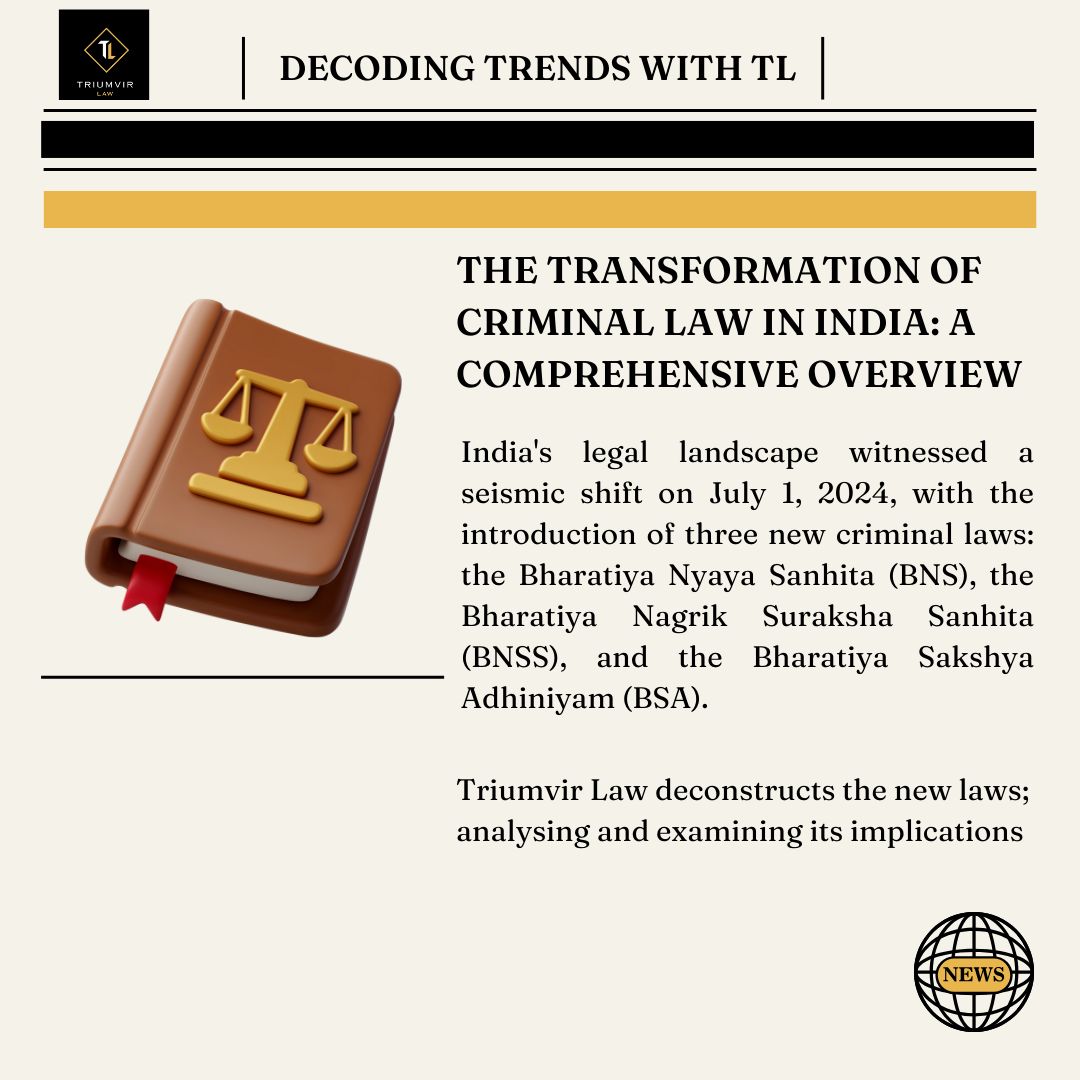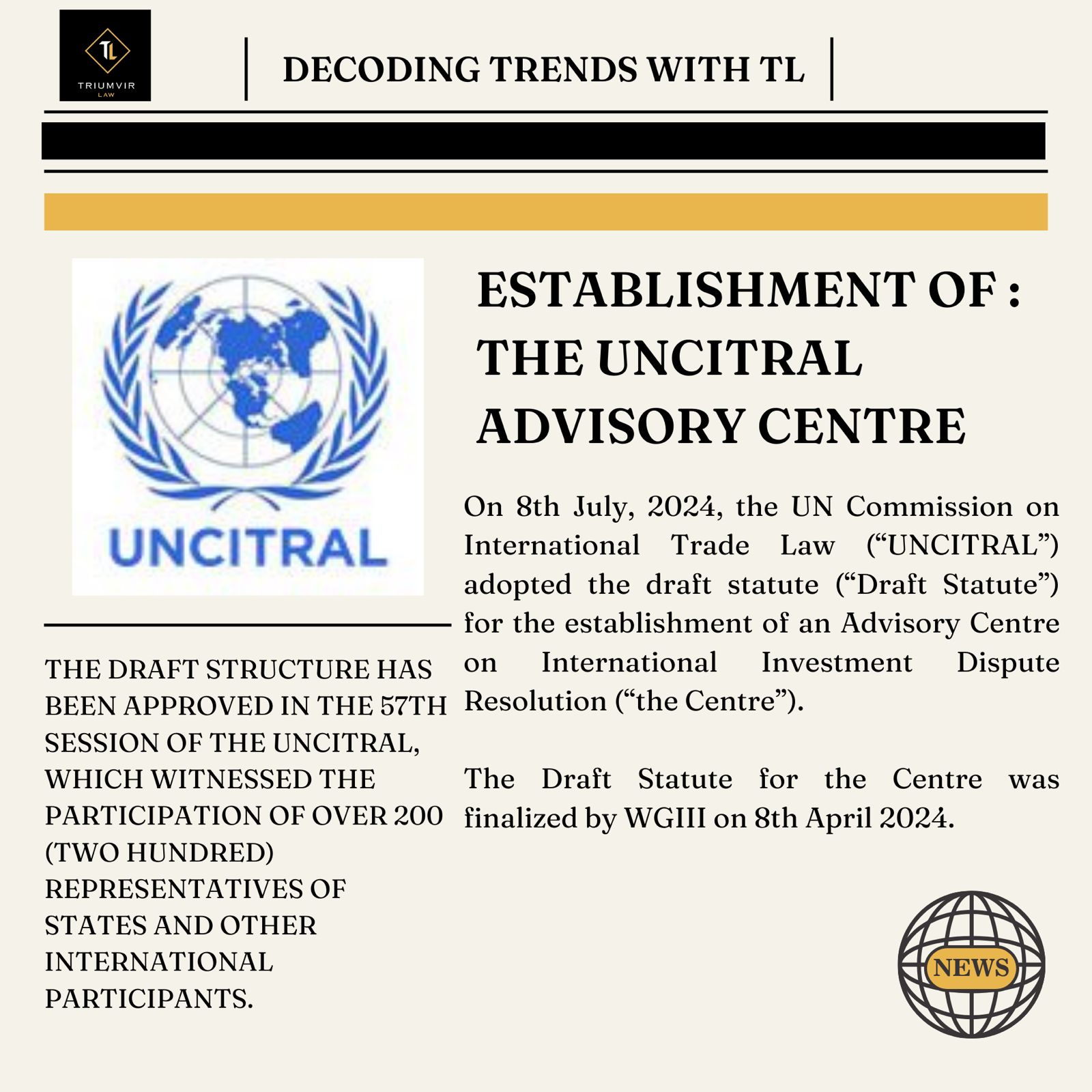
Decoding Trends With Trumvir Law

The Telecommunications Act: A Brief Overview of the New Regime
- March 13, 2024
- Decoding Trends With Triumvir Law
- Aakash Parihar & Ragini Chakraborty
BACKGROUND
India is the second-largest telecoms ecosystem in the world with a combined workforce of over 4 million people, which makes up around 8% of the country’s gross domestic product. In the present age characterized by technological breakthroughs such as 4G, 5G, Internet of Things, the fourth wave of industrial revolution, M2M Communications, Mobile Edge Computing, and others, India experiences emerging prospects for socio-economic development. Therefore, to adapt to the technological advancement in the telecom sector 21st century, it is crucial to establish a legal framework. The framework aims to incorporate the technological advancements in the telecom sector to further regularise the dissemination and usage of services to expand the regulatory ambit of the governing laws.
The Telecommunications Act, 2023 (“the Act”) enacted in December, 2023 provides a contemporary framework for regulating the telecommunication sector replacing the Indian Telegraph Act, 1885 (“Telegraph Act”) and the Indian Wireless Telegraphy Act, 1933 (“WTA”). In the last decade, the Government has implemented several measures to promote the expansion of the telecommunications industry which involve the rationalization of bank guarantees and interest rates, the permission of 100% Foreign Direct Investment (“FDI”) under the automatic route and the liberation of frequency bands.
The Act pertains to the regulation of telecommunication services in India. This represents a clear distinction from the Telegraph Act and has the potential to be a move towards a telecom regulatory system that separates infrastructure, networks, and services under different authorizations.
AMENDMENT TO DEFINITIONS UNDER THE ACT
The term ‘telecommunication network’ encompasses telecommunication equipment and infrastructure, such as terrestrial or satellite networks, as well as submarine networks. The scope of ‘telecommunication equipment’ has been expanded to encompass other components such as ‘radio station’, ‘radio equipment’, ‘user equipment’, as well as any ‘software’ and ‘intelligence’ that are essential to such telecommunication equipment. Telecommunication equipment, when considered in conjunction with the definitions of telecommunication network and telecommunication, is likely to encompass telecommunication equipment that includes software services or virtual network elements as outlined in the Act. However, the Government may amend these definitions to broaden their scope.
Applicability of the Act
The Act would apply beyond national borders to any violation or breach of the law stated in the statute that occurs outside of India. The Act encompasses acts of remote tampering or unauthorized access/interception of communications equipment or networks from outside India, and imposes corresponding offences and punishments. This bears resemblance to the provisions outlined in the Information Technology Act of 2000 and has the potential to be utilized in matters pertaining to national security. Moreover, the Universal Service Obligation Fund is renamed as Digital Bharat Nidhi and its utilization is expanded to include research and development purposes. This renamed fund is controlled by the Central Government and will be utilised towards research and development of telecommunication services and to ensure their widespread access.
AUTHORISATION UNDER THE NEW FRAMEWORK
Presently, the Department of Telecommunications (“DoT”) grants an array of licenses that come with certain authorizations. These licenses outline the specific terms and conditions that the telecommunication service provider must adhere to. The Act aims to streamline this procedure and facilitate company operations by removing the provision in the Telegraph Act that granted the Government the sole right to originate, operate, and grant licenses for telegraph in India. Contrarily, the Act employs the term ‘authorisation’, which refers to a Government-granted permission. Regardless of the Government’s right being termed as “exclusive privilege” under the Telegraph Act or “authorisation” under the Act, the Government reserves the sole right to grant licenses with respect to telecommunication services in India.
Individuals seeking to provide services under this Act must get authorization from the Government. The Government will determine the specific terms, conditions, fees, and charges associated with this authorization. The Government has the authority to grant such authorization in the Continental Shelf and Exclusive Economic Zone of India, subject to its compliance with the maritime laws and international laws that India has adopted and ratified. For the presently sanctioned licenses, the license, registration, or permission holder must finally transition to the appropriate authorizations granted under the Act. Any exemption from licensing that was previously granted under these regulations shall remain valid under the Act, until the Government provides a different notification.
SPECTRUM ALLOCATION
The Government will allocate the spectrum either through auction or through an administrative basis for certain purposes under the First Schedule of the Act. The First Schedule of the Act lists the entries for which assignment shall be done on an administrative basis. Administrative allocation will be done for matters related to national security, law enforcement, crime prevention, public broadcasting services, certain satellite-based services, and other relevant areas. The Government will also periodically notify a National Frequency Allocation Plan.
The Government has the authority to modify the First Schedule of the Act through notification, particularly when it is in the public interest to allocate spectrum for administrative purposes or for the execution of Government responsibilities. This can be done when an auction is not the preferable method of assigning spectrum due to technical or economic considerations. Every Government notification must be presented to both Houses of Parliament for examination.
The Government has authorized the sharing, trading, leasing, and surrendering of spectrum, as well as the realignment of frequencies to facilitate optimal authorization, subject to defined restrictions. The new law upholds the validity of executive decisions pertaining to spectrum assignment or telecom services that were carried out under prior Acts. It ensures that no legal processes can dispute the legitimacy of these activities.
USER SECURITY
The Government has the authority to establish regulations that can be used to enforce measures aimed at safeguarding and guaranteeing the security of communications networks and services. Cloud contact centre service providers are likely to be required to comply with measures related to traffic data, which includes data generated, transmitted, or stored in telecommunication networks, such as data about type and routing. These procedures may involve the gathering, examination, and distribution of traffic data that is produced, transmitted, received, or stored in telecommunication networks within India.
DND
The Act provides a definition for “specified message” as messages pertaining to commodities, services, property, business, employment, or investment possibilities. The Government will implement user protection measures like as consent requirements, Do-Not-Disturb registers, and reporting methods for malware or specified messages.
The Act offers user protections such as mandatory consent, Do Not-Disturb registries, and reporting systems. It enables the utilization of the legal privilege to establish telecommunication infrastructure on both public and private land.
RIGHT OF WAY
The Act implements measures to alleviate obstacles in acquiring ‘right of way’ authorizations in India. The Act establishes a definitive legal structure that allows authorized entities or their contractors/agents (known as the facility provider) to secure the right of way for the construction, maintenance, or expansion of telecommunication networks in a consistent and fair manner, without any discrimination. In addition to requesting the right of way from public bodies, the Act also permits authorized businesses to seek the right of way from private individuals. If the owner of the private property refuses the application, the Government may, in the interest of the public, decide that the facility provider should be allowed to use the right of way, with specific terms, conditions, and compensation as specified.
According to the Act, any communications network built on a property is not considered part of that property and is not subject to any claims, liquidation, or encumbrances. Moreover, individuals who choose to utilize their property in a way that may potentially harm or disrupt the telecommunication network or services are obligated to give advance notice to the facility provider, Government, or any notified authority. The resolution of any disagreement about the right of way will be handled by the district magistrate or any other authorized body designated by the Government, based on the geographical jurisdiction where the property is situated.
With the inclusion of provisions regarding right of way in the Act, the existing Indian Telegraph Right of Way Rules, 2016 will remain applicable as long as they do not conflict with the provisions in the Act or are replaced by new rules issued under the Act.
PUBLIC SAFETY
The Government maintains the authority to intercept or seize control of communications networks in the event of a public emergency or for the sake of public safety. The Act grants the Government significant authority to determine the length of these measures, without including any safeguards for the Government’s exercise of this power.
Consequently, Rule 419A of the Indian Telegraph Rules, 1951, which grants the Government the authority to issue instructions for message interception, and the Temporary Suspension of Telecom Services (Public Emergency or Public Safety) Rules, 2017, will remain in effect as long as they do not contradict the provisions of the Act or are replaced by new regulations.
ADJUDICATION UNDER THE ACT
Telecommunication service providers are required to establish an internet-based system for handling complaints and clearly define the procedures for resolving such complaints. The Act further mandates that, in existence of a dispute, the Adjudicating Officer and Designated Appeals Committee operate in a digital manner, adhering to digital office principles to the greatest extent feasible.
Additionally, it allows for a system of voluntary commitment in case the authorized entity or a spectrum assignee violates the terms and circumstances of an authorization or assignment or contravenes certain clauses that do not specify a penalty or punishment.
The acceptance of a voluntary undertaking can either prevent legal proceedings or be treated as a mitigating factor when assessing civil fines, depending on the stage of the determination process at which it is submitted. According to the Act, the Telecom Disputes Settlement and Appellate Tribunal will only have the power to hear appeals regarding disputes related to the violation of terms or the suspension/revocation of an authorization/assignment. The appeal must be filed within 30 days.
CONCLUSION
All regulations and directives established under the existing framework will remain in effect, if they are not in conflict with the requirements of the Act or are replaced by new regulations. Therefore, the current exclusions that allow for the creation, upkeep, or operation of private telegraph services will remain in effect until the Telegraph Rules are abolished. The mandate for mandatory testing and certification of telecommunication equipment (MTCTE), which was implemented in 2017 under the Telegraph Rules, will remain in effect until the Telegraph Rules are abolished.
The true extent of the proposed changes can only be determined if the required rules and regulations are established. However, it is undeniable that this represents a significant overhaul of a crucial sector of the economy. Until the regulations pertaining to the Act are made available, both incumbent players and potential entrants will face confusion regarding how the Act would govern their operations.
RECENT POST
SOCIAL SHARE
Related Post

Budget Takeaways 2024-25
Decoding Trends With Trumvir Law The Budget for FY 2024-2025, presented on July 23, 2024, aims to advance India’s growth

The Transformation of Criminal Law in India: A Comprehensive Overview
Decoding Trends With Trumvir Law India’s legal landscape witnessed a seismic shift on July 1, 2024, with the introduction of

Empowering Arbitration: The Advisory Centre on International Dispute Resolution
Decoding Trends With Trumvir Law I. Introduction On 8th July, 2024, the UN Commission on International Trade Law (“UNCITRAL”) adopted

